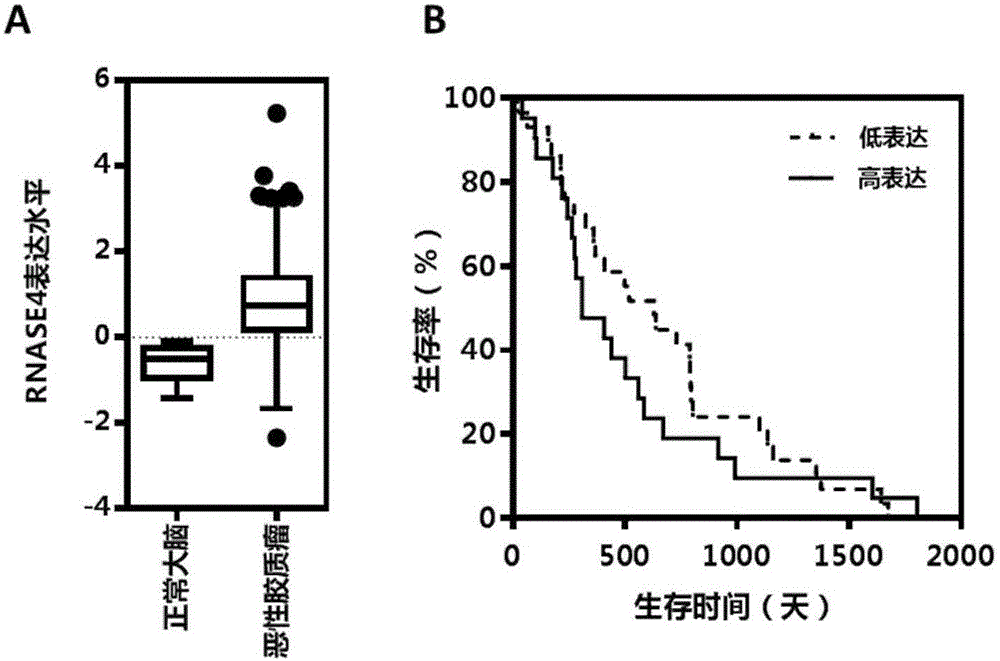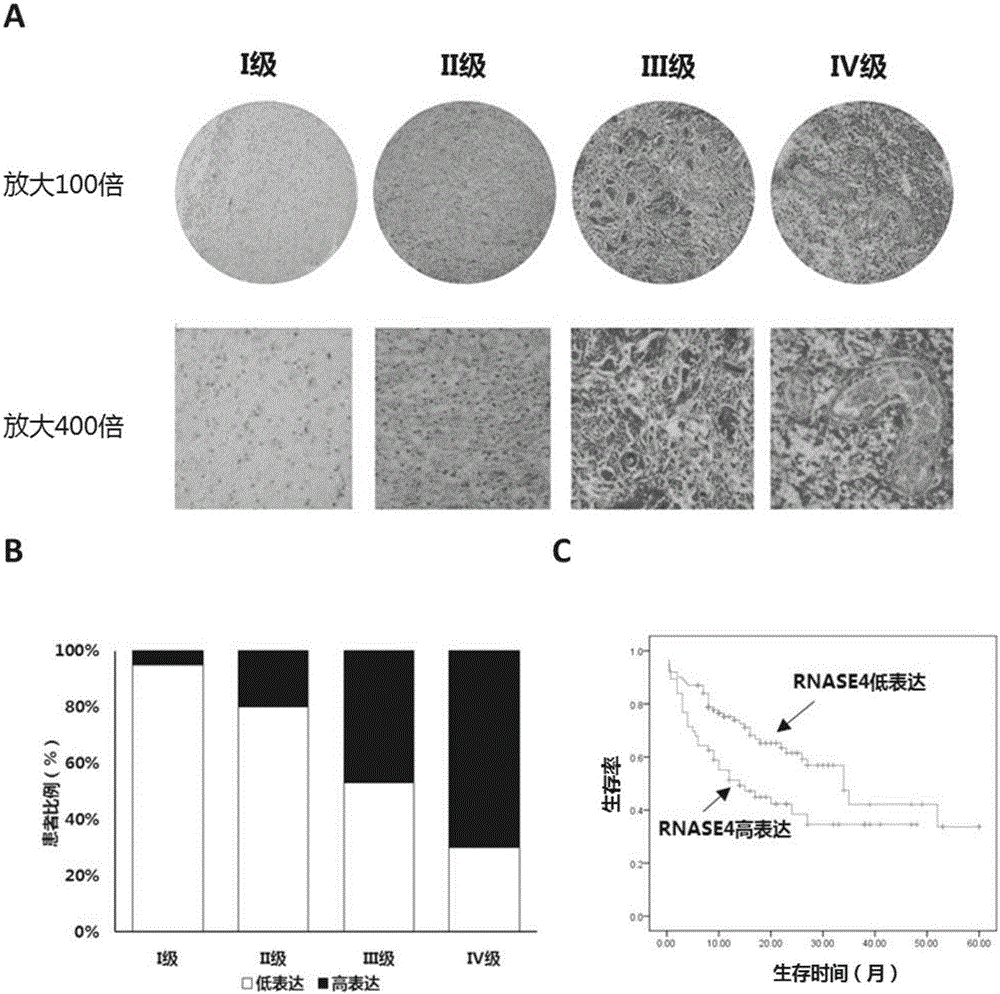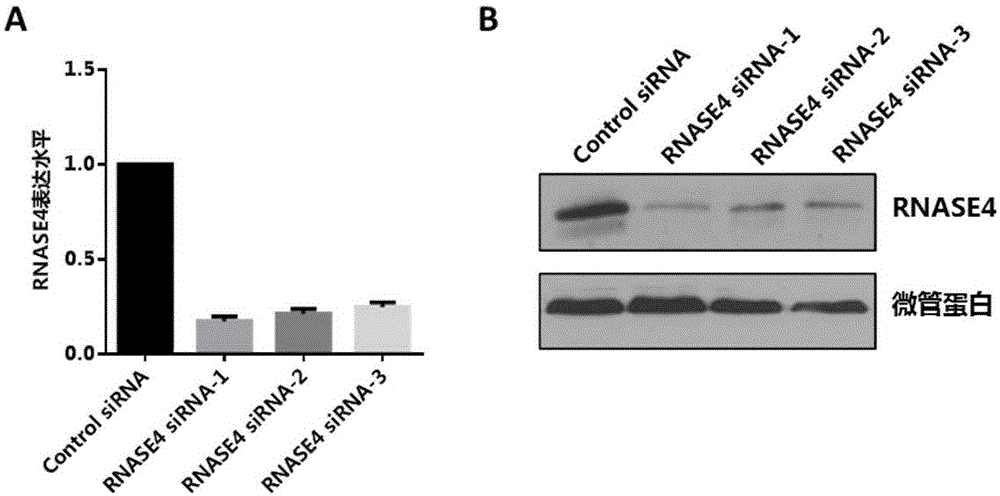Application of RNASE4 serving as drug target to brain glioma inhibition drugs
A glioma and drug technology, applied in the application field of RNASE4 as a drug target in glioma inhibitory drugs, can solve unknown problems, achieve the effect of expanding the scope, overcoming non-selectivity, and improving prognosis
- Summary
- Abstract
- Description
- Claims
- Application Information
AI Technical Summary
Problems solved by technology
Method used
Image
Examples
Embodiment 1
[0059] Example 1, the expression of RNASE4 protein in human glioma tissue
[0060] In order to study the expression of RNASE4 gene in glioma tissues, 430 tissues of glioma patients with different malignant degrees were collected and a series of related experiments were done. First, the expression of RNASE4 protein in glioma was analyzed by conventional immunohistochemical method, the results are as follows figure 2 shown.
[0061] Nuclei are stained blue by hematoxylin, showing cell number distribution. The brown-yellow part of the tissue developed by DAB (diaminobenzidine) (that is, the part shown in dark black in the figure) represents the expression of RNASE4 protein.
[0062] The results showed that the stained positive tissue cells were arranged disorderly, the degree of compactness and looseness was inconsistent, and the shapes and sizes of the nuclei were different. They were overgrown tumor tissue cells, and the brownish yellow staining of the nuclei was also very r...
Embodiment 2
[0064] Example 2, siRNA or shRNA targeting the RNASE4 gene can inhibit the growth of glioma cells
[0065] The siRNA or shRNA targeting the RNASE4 gene described above was introduced into the glioma cell U87MG to silence the expression of the RNASE4 gene, thereby inhibiting the growth of the glioma cell. The transfection process can be mediated by either siRNA liposomes or lentiviruses containing shRNA.
[0066] Wherein the liposome transfection steps are as follows: inoculate 0.3x10 6 A glioma cell U87MG was transferred to a 35mm cell culture dish, and the DMEM cell culture solution of 2ml was added to each dish, and placed in an incubator for cultivation (cultivation conditions were: 5% CO 2 ; temperature is 37 degrees), overnight, after the cells adhere to the wall, when the cell adhesion rate reaches more than 60%, prepare the transfection reagent ( 2000 transfection reagent, purchased from American Life Company, the article number is 11668027) and siRNA (entrusted to S...
Embodiment 3
[0069] Example 3: shRNA targeting the RNASE4 gene inhibits the growth of xenografted tumors in nude mice
[0070] Cell lines stably expressing RNASE4 gene shRNA were used to determine the efficiency of gene silencing. Afterwards, we randomly divided 18 5-week-old male nude mice into three groups, and subcutaneously injected glioma U87MG stably infected cell lines (ControlshRNA cell line, RNase-4shRNA-1 cell line and RNase-4shRNA-2, these three lines The cell line was isolated from the above-mentioned cells infected with lentivirus), and each mouse was injected with 5x10 6 cells / 200 μL. The cell viability before and after the injection of the ControlshRNA cell line was 97.02% and 96.53%, the cell viability before and after the injection of the RNASE4shRNA-1 cell line was 98.35% and 97.69%, and the cell viability before and after the injection of the RNASE4shRNA-2 cell line was 96.15% and 93.29%, respectively. %, therefore, the subcutaneous injection procedure did not affect c...
PUM
| Property | Measurement | Unit |
|---|---|---|
| molecular weight | aaaaa | aaaaa |
Abstract
Description
Claims
Application Information
 Login to View More
Login to View More - R&D
- Intellectual Property
- Life Sciences
- Materials
- Tech Scout
- Unparalleled Data Quality
- Higher Quality Content
- 60% Fewer Hallucinations
Browse by: Latest US Patents, China's latest patents, Technical Efficacy Thesaurus, Application Domain, Technology Topic, Popular Technical Reports.
© 2025 PatSnap. All rights reserved.Legal|Privacy policy|Modern Slavery Act Transparency Statement|Sitemap|About US| Contact US: help@patsnap.com



